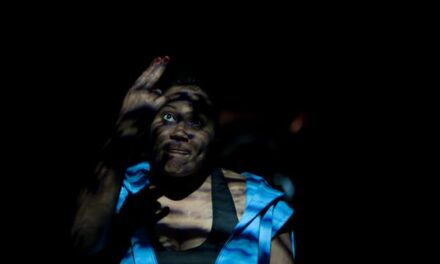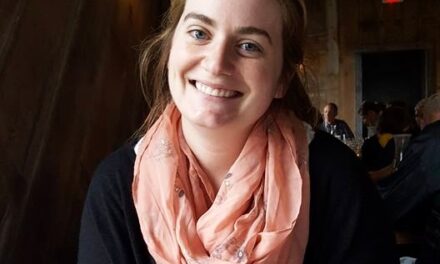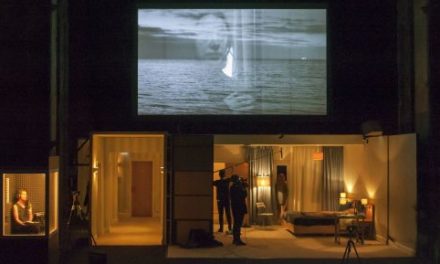Premiere Stages at Kean University begins its 15th season with an ending – the ashes of Maggie and Rosemary’s dead sister, Colleen, which, if all goes well, will be scattered into the ocean in a quiet memorial ceremony nearby a Florida beach house.
This is the basis of the 2019 Premiere Play Festival pick, The Wake, written by Tammy Ryan, who previously won in 2006.
Unsurprisingly, events do not turn out as planned, and an impending hurricane and emotional turmoil, along with a few surprise arrivals from animals indigenous to the swampy Florida lands, turn the week into a disaster that keeps growing and growing.
At first glance, the beach house set, designed by Bethanie Wampol Watson, was welcoming and cozy, with inviting but simple furniture and lots of open floor space. Yet a more detailed look showed facets of subtle uncleanliness, like an unfinished beer bottle on the coffee table, various chunks of garbage strewn all over the floor, and audiences learn later, a coating of sand from the beach. The mess is at first disorienting, but immediately transports you into the world of the play. It accurately mirrors the play’s later events, characters’ feelings toward each other, and the grief cycle, yet remains merely a subtle hint to the disaster about to strike. Coupled with the lighting (Greg Solomon) and sound effects (Emily Auciello), the set helped complete a trio of technical elements that made for an atmospherically moving play.
The wildlife props, however, left much to be desired. The creatures that mysteriously enter (or try to enter) the beach house are all obviously fake, but their unrealistic-ness clashes with the real feelings and events that make up the world of the play. The environmental aspect that the playwright was aiming for may have been heightened with only the idea of the wildlife to build upon, rather than having the actual “animals” there.
Clocking in at a hefty two and a half hours surprisingly did not weigh the play down – all in all, it felt quite short. However, no comparison can be made between the two acts; the latter half was indubitably stronger and sharper in terms of character and idea. Act one acted as a prop for development and background, and while important, could have been intermingled with the happenings of act two.

Kathy McCafferty as Rosemary, Kelley Rae O’Donnell as Maggie, James Gushue as Doyle, and Wayne Maugans as Ed in the Premiere Stages production of The Wake by Tammy Ryan | Photo Credits Mike Peters
Act two was also a wonderful breeding ground for character development in regard to the sisters. On the surface, both enter the picture seeming perfect in their own ways. Maggie (Kelley Rae O’Donnell) is a typical do-gooder, being the one to take care of her cancer-ridden sister in her final days. Rosemary (Kathy McCafferty) is living the upper-middle-class American dream with a loving husband (or so it seems), two kids, a family trip to Disney World every year, and a “my way or the highway” type mentality. When these facades crack, the audience gains insight into the third sister, Colleen, whose only physical stage presence is her ashes in an urn, but who is brought to life by the good and bad stories her sisters tell about her, as well as the way they share that she has impacted their lives in life and beyond it.
Doyle (James Gushue) and Ed (Wayne Maugans), on the other hand, didn’t seem to change much at all throughout the play. Sure, their backstories are revealed in time, but neither of them is much different when the story ends. This makes sense for Doyle both because he is outside of the family and his personality is eccentric—adding more would dehumanize him. Also, much of his character is clouded in mystery, and the fact that he stays that way is an advantageous choice on Ryan’s end. Ed is clearly Doyle’s opposite and the weakest of the characters—he is a stereotypical middle-aged white man with money.
Much of the anger and sadness that is embedded in Maggie and Rosemary (both toward each other and their deceased sister) is illustrated is screaming matches in the second act. These outbursts significantly allow them to release emotions that might otherwise be pent up and they do move the plot along toward an emotionally satisfying ending, but there are too many of them and they are not built up on smaller, less aggressive notes. Oftentimes coming out of the blue, they needed more manipulation in order for their outcomes to be even more striking then they are now.
The intersection of life and death played a heavy hand in all that the play brought up. Ryan expertly weaved in empathy and some hard truths – a person’s bad qualities just don’t disappear when s/he dies, but they should be remembered along with the rest of the person’s personality. While there is often an overabundance of nature versus nurture themes, Ryan gives it a fresh look through the sisters’ examination of their actions toward Colleen – did they wrongly influence her and drive her to an early grave or did she ruin her own life?
Ambiguity, character development, and unexpected events and emotions made The Wake an absorbing start to Premiere’s 15th season, though it does have kinks to work out. Some script tightening would of great benefit to the overall plot structure and the character interaction. Of course, no premiere is perfect, but the effort and care Premiere takes in setting new plays up for success is apparent and worthwhile, especially in The Wake.
This post was written by the author in their personal capacity.The opinions expressed in this article are the author’s own and do not reflect the view of The Theatre Times, their staff or collaborators.
This post was written by Madison Parrotta.
The views expressed here belong to the author and do not necessarily reflect our views and opinions.

















